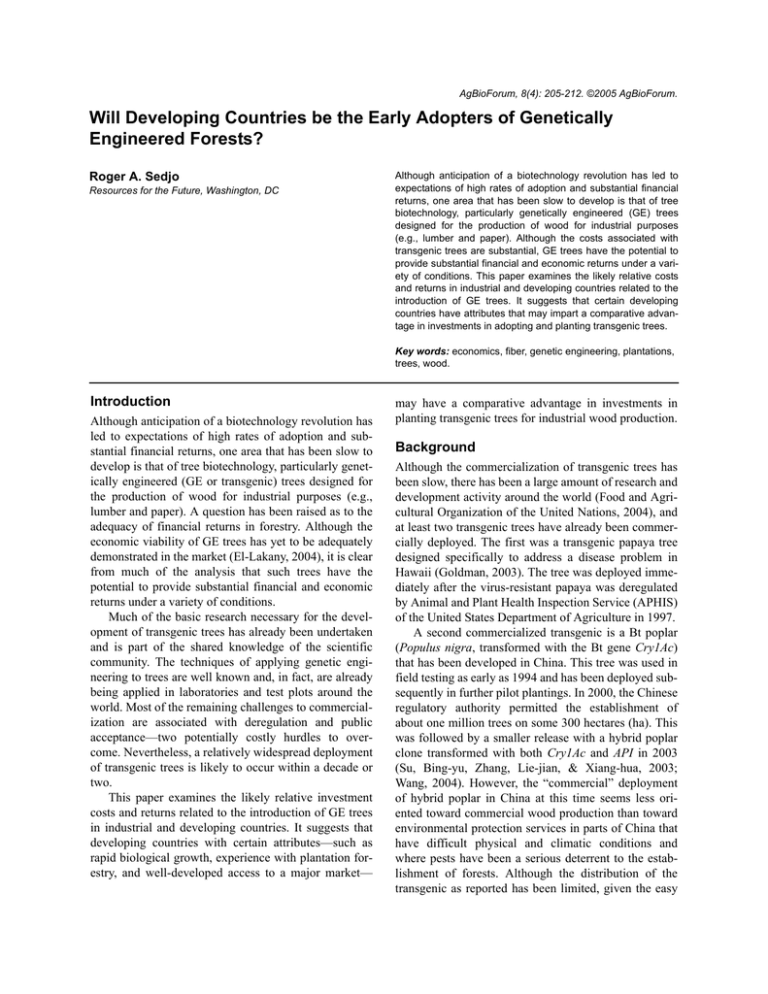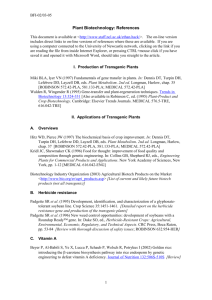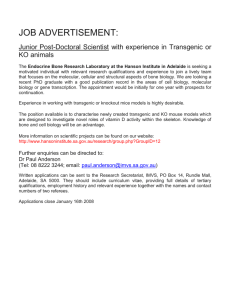Roger A. Sedjo
advertisement

AgBioForum, 8(4): 205-212. ©2005 AgBioForum. Will Developing Countries be the Early Adopters of Genetically Engineered Forests? Roger A. Sedjo Resources for the Future, Washington, DC Although anticipation of a biotechnology revolution has led to expectations of high rates of adoption and substantial financial returns, one area that has been slow to develop is that of tree biotechnology, particularly genetically engineered (GE) trees designed for the production of wood for industrial purposes (e.g., lumber and paper). Although the costs associated with transgenic trees are substantial, GE trees have the potential to provide substantial financial and economic returns under a variety of conditions. This paper examines the likely relative costs and returns in industrial and developing countries related to the introduction of GE trees. It suggests that certain developing countries have attributes that may impart a comparative advantage in investments in adopting and planting transgenic trees. Key words: economics, fiber, genetic engineering, plantations, trees, wood. Introduction Although anticipation of a biotechnology revolution has led to expectations of high rates of adoption and substantial financial returns, one area that has been slow to develop is that of tree biotechnology, particularly genetically engineered (GE or transgenic) trees designed for the production of wood for industrial purposes (e.g., lumber and paper). A question has been raised as to the adequacy of financial returns in forestry. Although the economic viability of GE trees has yet to be adequately demonstrated in the market (El-Lakany, 2004), it is clear from much of the analysis that such trees have the potential to provide substantial financial and economic returns under a variety of conditions. Much of the basic research necessary for the development of transgenic trees has already been undertaken and is part of the shared knowledge of the scientific community. The techniques of applying genetic engineering to trees are well known and, in fact, are already being applied in laboratories and test plots around the world. Most of the remaining challenges to commercialization are associated with deregulation and public acceptance—two potentially costly hurdles to overcome. Nevertheless, a relatively widespread deployment of transgenic trees is likely to occur within a decade or two. This paper examines the likely relative investment costs and returns related to the introduction of GE trees in industrial and developing countries. It suggests that developing countries with certain attributes—such as rapid biological growth, experience with plantation forestry, and well-developed access to a major market— may have a comparative advantage in investments in planting transgenic trees for industrial wood production. Background Although the commercialization of transgenic trees has been slow, there has been a large amount of research and development activity around the world (Food and Agricultural Organization of the United Nations, 2004), and at least two transgenic trees have already been commercially deployed. The first was a transgenic papaya tree designed specifically to address a disease problem in Hawaii (Goldman, 2003). The tree was deployed immediately after the virus-resistant papaya was deregulated by Animal and Plant Health Inspection Service (APHIS) of the United States Department of Agriculture in 1997. A second commercialized transgenic is a Bt poplar (Populus nigra, transformed with the Bt gene Cry1Ac) that has been developed in China. This tree was used in field testing as early as 1994 and has been deployed subsequently in further pilot plantings. In 2000, the Chinese regulatory authority permitted the establishment of about one million trees on some 300 hectares (ha). This was followed by a smaller release with a hybrid poplar clone transformed with both Cry1Ac and API in 2003 (Su, Bing-yu, Zhang, Lie-jian, & Xiang-hua, 2003; Wang, 2004). However, the “commercial” deployment of hybrid poplar in China at this time seems less oriented toward commercial wood production than toward environmental protection services in parts of China that have difficult physical and climatic conditions and where pests have been a serious deterrent to the establishment of forests. Although the distribution of the transgenic as reported has been limited, given the easy AgBioForum, 8(4), 2005 | 206 vegetative propagation of this hybrid poplar, the engineered gene has probably spread beyond the area of the original plantings (Su et al., 2003). Genetically engineered trees have potential financial value today because plantation forests have become a major supplier of industrial wood, gradually displacing wood gathered from natural forests over the past 30 years. Once a decision is made to plant trees rather than depend on natural regeneration, it almost always makes sense to plant trees with improved valuable traits. Many of these valuable traits can best be provided through genetic engineering of trees. Although industrial forest plantations today constitute about 2.5% of the world’s forested area of 3.9 billion ha, they account for roughly one third of the world’s industrial wood production (Carle, Vuorinen, & Del Lungo, 2002). Because most of the plantation production has come onstream over the past 25 years, at a time when total global industrial wood production has barely increased, the total industrial harvest from natural forest has surely decreased both absolutely and as a share of total production. Projections estimate that plantations will account for 50% of global industrial wood production by 2025 and up to 75% by 2050 (Sohngen, Mendelsohn, & Sedjo, 1999). Such a shift would almost surely reduce even further the industrial logging pressures on existing natural forests.1 Reasons for this change include the improving economics of planted forests through increased productivity due to intensive management, choice of species, improved germplasm, and the economies of scale on favorable sites. Simultaneously, the relative costs of wood from natural forests are generally increasing as extraction costs increase due to forest set-asides, stricter forest practices regulations, and more inaccessible sites.2 The benefits from the introduction of biotechnology to forestry are varied and potentially large. The economic benefits of transgenics will ultimately be found in the form of lower production costs, improved productivity, and a corresponding increase in availability and affordability to consumers of wood and wood products. Environmental benefits include decreased pesticide use and reduced logging pressures on natural forests. Moreover, transgenic trees can be designed to rehabilitate 1. See Friedman and Charbley (2004) for a discussion of this impact. 2. For example, harvests in 2003 from US National Forests were about 16% of what they had been 15 years earlier or about 2% of total US harvests, reflecting the declining use of these natural forests for timber production purposes. Table 1. Investment stages for conventionally bred and transgenic trees. Unique to transgenics? Stage Cost type I Development costs No II Deregulation costs Yes III Distribution costs; incremental stigma costs Yes IV Time costs, planting to market; unique to trees No despoiled lands through the application of phytoremediation technology, which exploits the actions of plants and their associated microbes to clean up hazardous soil contamination. Investments in Improved Forest Trees Starting with a stock of basic research knowledge, one can think of the development of improved trees as involving a number of types or stages of investments. Many of the world’s developing countries have expertise adequate to access that stock of basic research and provide subsequent technical improvements to the tree seed stock. Table 1 lays out four investment (cost) stages in the development of a new forest tree, two of which are unique to transgenic trees. Specifically, investment costs for a innovative transgenic tree typically consist of: (a) the development costs for the new transgenic product (e.g., the disease-resistant gene as applied to a particular species of planted tree); (b) the costs required to deregulate the new transgenic product, given that in most countries a transgenic plant is automatically a regulated article requiring deregulation before it can be used commercially; (c) the additional distribution costs required to overcome public opposition or stigma;3 and (d) the time costs between when the tree is planted and when the benefits are captured and monetized at harvesting. With positive discount rates in the society, the time delay between incurring costs and receiving benefits tends to discourage investments. Although significant time costs are not required for annual agricultural crops, they are associated with multiyear planted forests, whether transgenic or not. The middle two categories of investment costs apply only to transgenic innovations. These extra costs sug3. “Stigma” refers to a decidedly negative view of the product by a significant portion of potential consumers. The term denotes nothing about the cause or justification of that attitude. Stigma is reflected in a reduced demand for the product and perhaps political action against the product and/or process. Sedjo — Will Developing Countries be the Early Adopters of Genetically Engineered Forests? AgBioForum, 8(4), 2005 | 207 Table 2. Forest traits that can be improved through biotechnology. Silviculture Adaptability Wood quality traits Growth rate Nutrient uptake Crown/stem Flowering control Herbicide Drought tolerance Cold tolerance Fungal resistance Insect resistance Wood density Lignin reduction Lignin extraction Juvenile fiber Tree form, branching gest that, other things being equal, the developer would prefer investments in nontransgenics. Of course, other things are not necessarily equal, because genetic engineering allows transformations that could not be accomplished using traditional approaches. Even when a transformation could be achieved through traditional breeding, genetic engineering may provide less expensive means (Carson, Walter, & Walter, 2004). Thus, the interest in the potential of transgenic trees is high in the forest industry. Potential High-Return GE Tree Innovations Table 2 provides a grouping of characteristics and traits of interest in forestry, including silvicultural features, environmental adaptability, and wood characteristics. Transgenic trees offer the potential of producing a product—industrial wood—with a number of desired traits. The transformation can be such that the wood can be more valuable by virtue of wood-quality traits that are desirable in themselves (e.g., density, which improves strength); lignin reduction and tree form, which decrease processing costs; disease and pest resistance, which reduce management and protection costs; adaptability, which allows commercial forests in previously unproductive sites; and flowering control, which may be a prerequisite to deregulation in some contexts and might also relieve stigma concerns and costs. Table 3 lists five promising biotechnological innovations with estimates of their likely benefits. All five innovations involve specialized transgenic transformations to impart traits that involve no additional operating costs, other than seedling costs that would be expected to be higher because they would incorporate the transgenic technology. For the five listed innovations, the transgenic tree would provide benefits either through reduced mortality and/or tending costs during the grow- Table 3. Possible financial gains from future biotech innovations. Innovation Benefits Wood density gene Improve lumber strength Herbicide tolerance gene in eucalyptus (Brazil) Reduce herbicide and weeding costs, potentially saving $350 or 45% per ha Improved fiber characteristic Reduce digester cost, potentially saving $10 per m3 Reduced amount of juvenile wood Increase value $15 per m3 (more useable wood) Reduced lignin Reduce pulping costs by up to $15 per m3 Note. Data from Context Consulting (n.d.). ing cycle or increased or higher-quality outputs, such as more desired wood characteristics.4 The value of these benefits is quantifiable when processing cost reductions are known (e.g., decreased digester costs) or the market value of product quality improvement is known (e.g., a premium price for lumber with improved characteristics). Thus, if the values of the innovations are captured in lower production costs or a high market price for the product, it would be reflected in higher market prices for the transgenic seed or seedling. Investments that Shorten the Long Time Frames Although the long life of tree growing imparts forestry with a financial disadvantage, this situation need not be prohibitive. The tremendous expansion of industrial tree planting by the private sector in the last decades of the 20th century, for example, demonstrates that long-term investments in trees can have returns adequate to attractive financial capital. Additionally, where GE innovations are involved, not all these innovations need await final harvest to experience a financial payoff. A number of possible innovations have the potential to reduce costs early in the plantation growing cycle (Table 4), generating benefits, for example, as substitutes for expensive pesticides and through reduced mortality. It is worth noting that the two transgenic trees currently commercialized—the disease-resistant papaya and Bt poplar—both generate benefits early in the growing cycle in the form of resistance to disease or pests. Similarly, herbicide tolerance—an 4. Many of these traits could, in principle, also be obtained using traditional breeding. Sedjo — Will Developing Countries be the Early Adopters of Genetically Engineered Forests? AgBioForum, 8(4), 2005 | 208 Table 4. Period of benefit capture. Period of benefit capture Innovation Financial benefit Herbicide tolerance Reduced weeding costs Plantation establishment (1–3 years) Bt gene Reduced pesticide use Early/mid rotation cycle (1–10 years) Fiber Reduced processing Postharvest (harvest improvement costs; improved fiber 10–40 years) quantity Sterility or changes in reproduction Reduced gene flow May be a condition of planting or improved product acceptance Table 5. Comparative investment costs: industrial and developing countries. Industrial countries Developing countries Development costs (stage I) Comparable Comparable Deregulation costs (stage II) High Low Distribution costs (stage III) Comparable Comparable Investment Stigma costs (stage III, cont.) Time costs (stage IV) High Low Generally higher Generally lower innovation of considerable interest—would also generate financial benefits through reduced weeding costs in the establishment phase (years 1–3) of the plantation growing cycle. Flowering control may be viewed as an enabling technology that may not reduce early costs, but without which deregulation might not be achievable. Toward Commercialization: Factors Providing Country Advantages The foregoing suggests that under many conditions, GE trees would have the potential to generate substantial financial and economic returns. The question arises as to which countries are best suited to take advantage of these potential returns. The working assumption of economics is that the innovative technologies will move to the locations where their probability of capturing the potential financial benefits is greatest. Table 5 provides a relative comparison of five categories of investment costs (stigma costs are separated from other distribution costs) required for a transgenic tree in industrial and developing countries. For two of the categories, development and distribution, the costs appear to be roughly comparable.5 However, for three categories—deregulation, stigma, and time-cost categories—the costs are likely to be substantially lower in certain developing countries than in many industrial countries, where they tend to be quite high.6 For deregulation and stigma, the lower costs reflect the fact that developing countries are generally less averse to GE products. Developing countries often have lower time costs, due to the shorter harvest rotations common in tropical and subtropical locales.7 Although it is sometimes maintained that some developing countries lack the scientific expertise to develop transgenic trees, much of the basic research necessary for the development of transgenic trees has already been undertaken and is part of shared knowledge in the scientific community. Thus, in many cases the developing country has the necessary technical expertise. Most of the remaining challenges undermining the deployment of transgenic trees are associated with deregulation and public acceptance. The deregulation process can be costly, in part because it typically requires that the product be judged safe from not only a health and safety perspective, but also from an ecological view. Thus, for example, extra costs are likely to be incurred engineering controls such as flowering restraints or sterility. Additionally, the public must be assured of the transformed tree’s safety, and public education may be costly. Some developing countries may have a comparative advantage in deregulation of transgenics. Deregulation standards and procedures are determined on a countryby-country basis. A study by Pray (2005) of crop deregulation suggested that a local developer or a multinational with a domestic partner appears to a have substantial advantage when it comes to achieving fast and low-cost deregulation. The optimum approach may be to form a joint venture between a international biotech company with a partner in the countries of interest. The local partner may then become the major agent in the deregulation process in the developing country with both partners sharing the proceeds from the revenues resulting from the deregulated transgenic. There is also the question of country sensitivity (stigma) to GE products and, more generally, the degree of commonly shared ecological concerns within a country over possible sources of damage, such as gene 5. The separation between development and deregulation costs is somewhat arbitrary, because some development costs are incurred to insure the product can overcome the regulatory hurdle. 6. The seven countries that are specifically considered are listed in Table 6. 7. Assuming real interest rates are comparable. Sedjo — Will Developing Countries be the Early Adopters of Genetically Engineered Forests? AgBioForum, 8(4), 2005 | 209 escape, which could affect the cost, ease, and timing of deregulation. Additionally, the likelihood of ecological damage may vary considerably depending upon the type of tree that is transformed and the forest environment. For example, questions have been raised about the implications of the deregulation of transgenic loblolly pine in the United States, particularly concerns about gene escape to indigenous pine trees (Williams, 2004). Such concerns could delay and otherwise increase the deregulation cost of transgenic pine in the United States. Such concerns, however, are likely to much less when the transgenic is an exotic (e.g., transgenic pine or eucalyptus in Brazil), because there are no native forest trees of the same or related genus and thus very little likelihood of gene escape to native forests (DiFazio, Gancho, Burczyk, Leonardi, & Strauss, 2004). The different levels of concern among countries may reflect either legitimate scientific recognition of very different levels of environmental risk or simply attitudinal differences having little scientific basis. In addition to the above-mentioned underlying cost and acceptability considerations, there are at least two other factors determining whether a country is amenable to GE trees. First, countries that have been active in global wood markets would appear to have in place the expertise and competitive advantage to take full advantage of transgenic trees. Second, any widespread transgenic program will require a tree type (species) that, once transformed, can quickly be replicated or “bulked up” from a few laboratory transgenic trees to millions of low-cost seedlings that can be commercially deployed. Because techniques (e.g., somatic embryogenesis) for pine clonal reproduction are still quite costly and have not yet experienced widespread deployment (Sedjo, 2004), countries or regions that depend primarily on conifers might well experience a delay before the enabling technology—low-cost cloning—is adequately developed.8 By contrast, many deciduous trees are relatively easy to replicate through vegetative propagation. International Trade In concept, trade in transgenic products can involve two different types of goods: the wood or wood product of the transgenic tree and its live germplasm, which is available for planting and reproduction. Thus, there are two possible industries: that of the tree transgenic produce developer and that of the tree grower. Access to 8. Note that these clonal techniques are not regulated and therefore require no deregulation costs. international markets is likely to be different for the two industries. In general, under the Global Trade Agreement (GTA), an innovative commodity is not eligible for international trading restrictions unless deemed to be a health or safety hazard, which has often been the argument against transgenic crops. In the case of wood, however, the commodity would be either raw wood, in the form of logs, or wood products such as lumber, pulp, paper, or furniture. In none of these cases does it appear that a serious argument can be made for trade restrictions based on health, safety, or concerns of initiating environmental damages in the importing country related to the transgenic nature of the tree, because the wood cells would be dead.9 By contrast, the transgenic germplasm—the living modified organism (transgenic) plant or its live seed—could be regulated at the border by virtue are health and safety arguments and/or the general regulation most countries place on live transgenic plants (see Sedjo, 2005b). Which Countries Will Lead? If countries that are the most likely to invest in the near term in transgenic trees and in achieve deregulation of transgenics are those that have the greatest potential financial gains, we would expect them to have a tree type that has a large market with few technical problems. Table 6 compares seven countries in terms of the tree type common in their plantations and the size of their domestic market as a proxy for the overall availability of markets. This table suggests that GE trees are most likely to become commercial first in countries that (a) already have large areas of well-functioning plantation forestry and areas for expansion; (b) have a species for which a large market exists, either domestically or abroad; and (c) have a species that can readily be transformed at relatively low costs. Given the above considerations, where and how might we expect transgenic tree deregulation and commercialization in the future? First, deciduous tree types are the most likely to be genetically engineered, due to the high replication costs associated with conifers. Furthermore, the countries that initiate large-scale commercial transgenic plantation are 9. It is worth noting that despite international agreements under the GTO that lay out biosafety criteria, guidelines, and conditions under which imports may or may not be banned, the importation of GE products continue to be banned. (See International Service for the Acquisition of Agri-Biotech Applications, 2005.) Sedjo — Will Developing Countries be the Early Adopters of Genetically Engineered Forests? AgBioForum, 8(4), 2005 | 210 Table 6. Tree types and market size. Table 7. The tale of two countries: China and Brazil. Country Tree type Domestic market Australia Coniferous and deciduous Modest Brazil Conifer and deciduous Large Tree experience: planted forests China Deciduous Large Deregulation procedures Chile Conifer Modest Tree type Poplar Eucalyptus New Zealand Conifer Modest Public acceptance Widespread Widespread South Africa Conifer Modest No Conifer Large Current transgenic trees Yes US South Active tree breeding/ GE research Yes Yes likely to have a friendly deregulation process and a population that is not overly concerned about transgenic issues and particularly transgenic trees. The ease of deregulation may depend on the extent of concerns of gene escape to wild forest populations. These deregulation concerns may be greater in industrial countries, where transgenics will likely be domestic species. More generally, certain developing countries appear to have advantages both in tree growing and in the possibility of low-cost transgenic tree deregulation. The most likely countries involved initially in GE tree commercialization appear to be China and Brazil (Table 7). No country in the world has more land in planted forests than China. China’s GE research, development, and commercial applications have been stimulated primarily by the Chinese government with strong ecological/protective purposes in mind. China has planted large areas in poplar, pine, and exotic species. In western China, a “Great Green Wall” of forest is being established to help control impending desertification. It is difficult to imagine China not making use of transgenic trees that offer serious advantages even given some international opposition. Once developed, the incremental costs of the transgenic poplar are likely to be negligible. Moreover, transgenics can aid in insect resistance without requiring large doses of expensive and often environmentally harmful pesticides. If a pestresistant Bt transgenic poplar is used effectively in China and the large demands of the Chinese economy for industrial wood continue, there is little reason to expect that other transgenic trees will not also be introduced to enhance industrial wood production and wood properties. Brazil, by contrast, is likely to look toward transgenic trees to enhance its already formidable advantage in certain types of industrial wood production, particularly pulpwood. Research and development in Brazil comes largely from the private sector with a strong industrial orientation. Although it has been anticipated China Market size Brazil Large Large Abundant Abundant Modest costs Likely modest costs that the expansion of Brazil’s domestic market will eventually draw a large portion of its production out of the international market and into the domestic market, this has yet to occur. Indeed, given the high yields and the large areas of land suitable for plantations, there is no physical reason why Brazil could not continue to produce large and growing volumes of industrial wood for both domestic and international markets. However, given the time required for planting and growing large areas of transgenics, we would agree with Seppala (2003) that it would be difficult to have significant impacts on timber and the forest products industry until after 2020. The ecological implications of transgenic trees in China and Brazil are likely to be substantially different. In Brazil, the ecological implications are likely to be minimal, in that the eucalyptus is an exotic and therefore gene escape is unlikely to impact native species anywhere in the western hemisphere. Additionally, a eucalyptus with greater fiber content will almost surely not provide additional fitness in the wild to the transformed tree. Also, should Brazil introduce transgenic pine, again the ecological implications are likely to be small given the absence of indigenous pine. Thus, ecological objections to the use of either transgenic eucalyptus or pine in Brazil are likely to be weak and noncompelling. In the longer term, the implications may be increased specialization in industrial wood production in a few very productive regions. These are likely to be the tropics and subtropics, in the absence of innovations that allow for very high growth and yields in the temperate and/or boreal regions. Genetic Tree Activity: The United States and Elsewhere In general, one would expect the adoption of transgenic trees to be most readily accomplished where the net Sedjo — Will Developing Countries be the Early Adopters of Genetically Engineered Forests? AgBioForum, 8(4), 2005 | 211 benefits would be greatest and a low level of adoptions (and perhaps active opposition) where net benefits are modest or nonexistent. In Europe, by contrast with China, Brazil and perhaps other parts of the tropics, the economic gains associated with transgenic trees are likely to be quite modest. The longer growth periods required for maturity bode against the types of high-cost intensive management that are likely to be associated with commercial deployment of transgenic trees. Simply assuming that it would take a narrow economic self-interest perspective, it is unlikely that the EU would be very receptive to the importation of transgenic tree germplasm for establishing forests, because it has little to gain by taking a positive view of transgenic trees. This position, furthermore, is consistent with the overall negative view of EU countries to transgenics plants in general. The situation with the United States is quite different from either China and Brazil, Europe, or tropical countries. Although the US has been a leader in the development, deregulation, deployment, and commercialization of transgenic crops, deregulation of a transgenic forest tree may be some time off. The example of the deregulation of the papaya may be more of an exception than a sign of more tree deregulation soon to come. Being a industrial country, the United States faces many of the same obstacles to transgenic regulation listed above that face other industrial countries. Much of the US has relatively modest yields and long rotations; therefore, the financial advantages of trangenics may be modest at best. However, some regions enjoy relatively high yields and short rotations (e.g., the South), although these regions are not as favorable as parts of the tropics and subtropics. Transgenic tree research in the US is oriented toward conifer (particularly pine) and poplar. Both of these tree types are growing in plantations in the US and elsewhere. There are, however, obstacles to the near term deployment of transgenic pine. As noted earlier, pine will need a facilitating lowcost technology in the development of clonal pine. Although progress is being made, further work is needed to develop low-cost applications. Although the above suggest relative high costs with the deregulation and deployment of transgenic trees in the United States, the possibility exists that the tree developments and improvements that take place there could be deregulated and deployed abroad. The opportunities for successful deployment look most promising in regions such as South America, southern Africa, and perhaps tropical Asia. Indeed, it may be that the first applications of the deregulated transgenic pine will occur in countries without native pine (e.g., southern hemisphere tropical regions like South America or New Zealand). Summary and Conclusions This paper suggests that GE trees have the potential to provide substantial financial and economic returns under appropriate conditions and that these conditions might be particularly favorable in developing countries with certain preexisting conditions. Thus, the deployment of transgenic trees may first be accomplished in a major way in countries where the deregulation costs are modest and potential benefits large. Two suggested candidates are China and Brazil. Over the longer period other countries with similar favorable situations are likely to participate. Although important technology has been developed primarily in the industrial world, the better utilization sites are likely to be found elsewhere. Transgenic trees are not likely to be equally profitable everywhere, however. A dichotomy in the use of transgenics could further increase the comparative advantage of the adopters over the nonadopters. The continued relocation of the forest industry could place additional competitive pressures on the forest products sectors of traditional woodproducing countries, even without the introduction of transgenics. References Carle, J., Vuorinen, P., & Del Lungo, A. (2002). Status and trends in global forest plantation development. Journal of Forest Products, 52(7), 12-13. Carson, M., Walter, C., & Walter, S. (2004). The future of forest biotechnology. In R. Kellison, S. McCord, & Kevan M.A. Gartland (Eds.), Forest biotechnology in Latin America (pp. 13-40). Raleigh, NC: Institute for Forest Biotechnology. Context Consulting. (n.d.). Untitled data. West Des Moines, IA. DiFazio, S.P., Gancho, T.S., Burczyk, J., Leonardi, S., & Strauss, S.H. (2004). Gene flow from tree plantations and implications for transgenic risk assessment. In C. Walter & M. Carson (Eds.), Plantation forest biotechnology for the 21st century. Kerala, India: Research Signpost. El-Lakany, M.H. (2004). Are genetically modified trees a threat to forests? Unasylva, 55(217), 45-47. Food and Agricultural Organization of the United Nations. (2004). Preliminary review of biotechnology in forestry: Including genetic modification (Forest Genetic Resources Working Paper). Rome: Forestry Department, FAO. Friedman, S., & Charbley, S. (2004). Environmental and social aspects of the intensive plantation/reserve debate. In S.H. Strauss & H.D. Bradshaw (Eds.), Forest biotechnologies: Sedjo — Will Developing Countries be the Early Adopters of Genetically Engineered Forests? AgBioForum, 8(4), 2005 | 212 Technical capabilities, ecological questions, and social issues in genetic engineering of plantation trees (pp. 141-162). Washington, DC: Resources for the Future. Goldman, M.L. (2003, February). Legal perspective on the transgenic papaya licensing program. Paper presented at Modifying Reproduction in Urban Trees, North Carolina Biotechnology Center, Research Triangle Park, NC. International Service for the Acquisition of Agri-Biotech Applications. (2005). EU Council fails to lift illegal bans on GM products. CropBiotech Update, July 1. Available on the World Wide Web: http://www.isaaa.org/kc/Bin/cbtupdate/index.htm. Pray, C. (2005, March). Registration requirements and their costs and implications: Lessons from LDCs. Paper presented at a meeting on the Economics of Regulation of Agricultural Biotechnologies, Arlington, VA. Sedjo, R.A. (2004). Genetically engineered trees: Promise and concern (RFF Report). Washington, DC: Resources for the Future Sedjo, R.A. (2005a). Genetically engineered forests: Financial and economic assessment to the future (draft report). Rome: FAO. Sedjo, R.A. (2005b). Global agreements and U.S. forestry: Genetically modified trees. Journal of Forestry, 103(3), 109-113. Seppala, R. (2003). Forest biotechnology and the global forest sector. In S. McCord & K. Gartland (Eds.), Forest biotechnology in Europe: The challenges, the promise, the future (pp. 39-43). Raleigh, NC: Institute for Biotechnology. Sohngen, B., Mendelsohn, R., & Sedjo, R.A. (1999). Forest management, conservation and global timber markets. American Journal of Agricultural Economics, 81(1), 1-13. Su, X., Bing-yu, S., Zhang, H.Q., Lie-jian, H., & Xiang-hua, Z. (2003). Advances in tree genetic engineering in China. Paper submitted to the XII World Forestry Congress, Quebec, Canada. Wang, H. (2004). The state of genetically modified forest trees in China. In Preliminary review of biotechnology in forestry: including genetic modification (Forest Genetic Resources Working Papers). Rome: Forestry Department, FAO. Williams, C.G. (2004, January). Genetically modified pines at the interface of private and public lands: A case study approach. Paper presented at USDA Forest Service, Washington, DC. Acknowledgements The author would like to acknowledge the assistance of the following in the preparation of a broader unpublished report (Sedjo, 2005a), from which parts of this paper were drawn. These include Oudara Souvannavong, Michael Martin, CTS Nair, Eva Muller, and Douglas Kneeland of the FAO Forestry Department, Rome, Italy. In addition, I would like to thank Pierre Sigaud and Jim Carle for their help, particularly with technical issues. Also, I would like to thank Hosny El Lakany, the Assistant Director-General for Forestry, and David Harcharik, Deputy Director General of FAO, for their assistance in arranging my appointment at FAO. However, the views expressed here are solely those of the author. Sedjo — Will Developing Countries be the Early Adopters of Genetically Engineered Forests?







